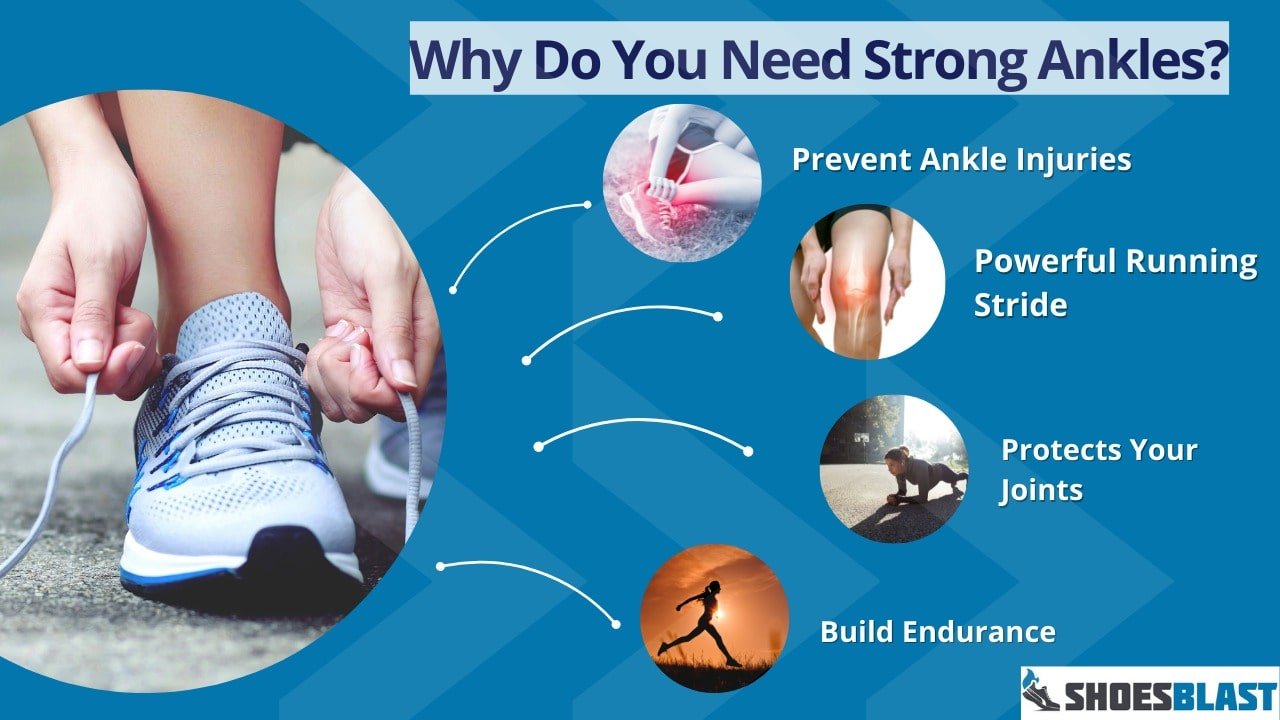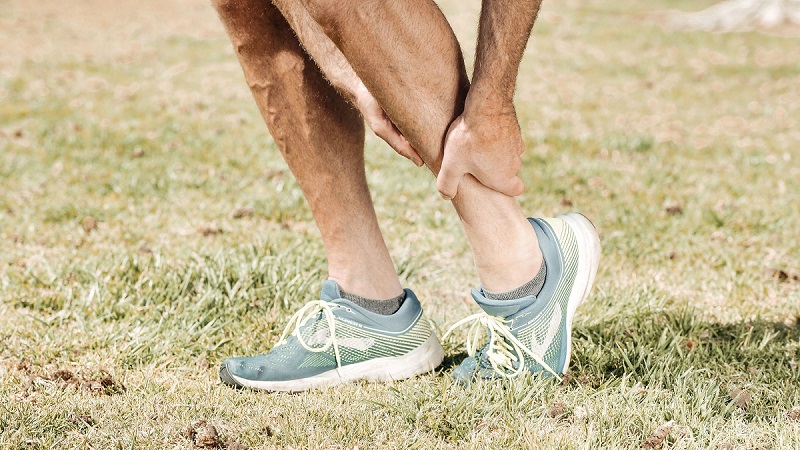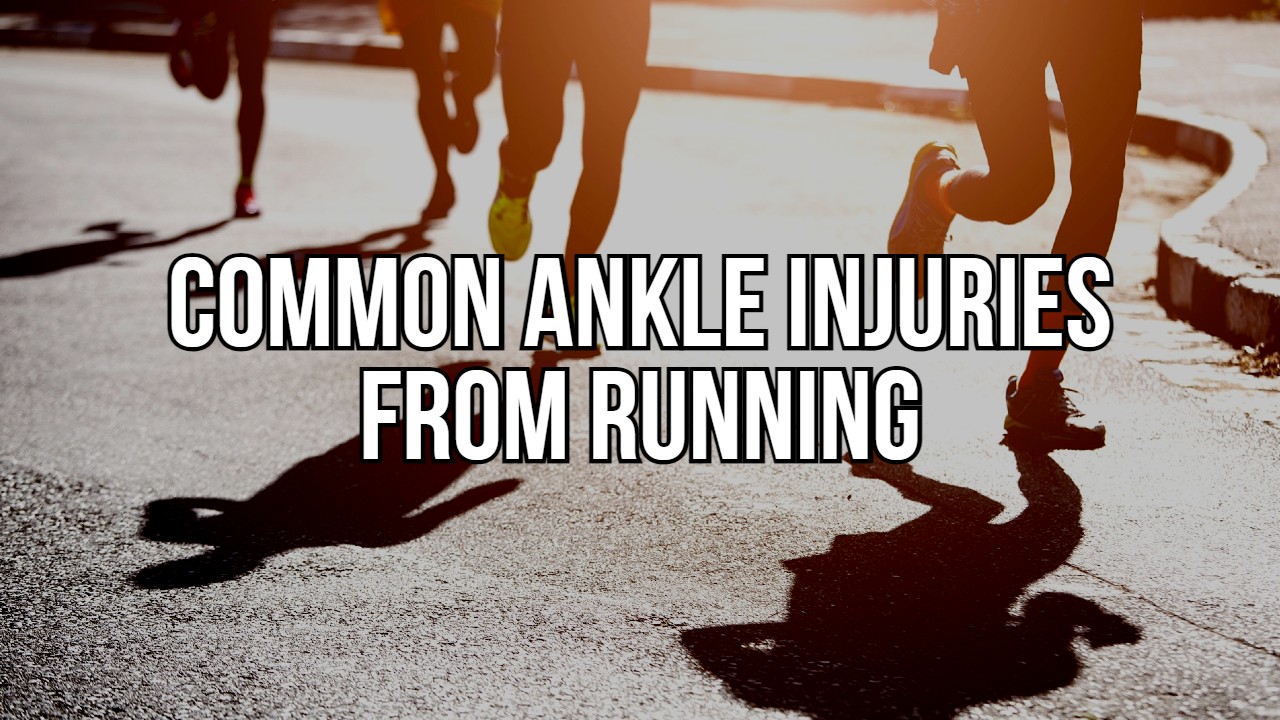[box]
In This Article
- Why do you need strong ankles
- 3 Common Ankle injuries & their treatments
- 1- Ankle Sprain
- 2- Achilles Tendinitis
- 3- Ankle Stress Fracture
- Exercises to strengthen weak ankles
[/box]
[box]
What’s more frustrating than a burning pain slowing you down on the running track? And if you ignore these pains and keep running, it might turn into a severe ankle injury such as a stress fracture, chronic pain, or ankle sprains.
We have often seen runners and athletes neglect their ankle pain. They continue doing strenuous exercises that weaken their ankles and affect their athletic performance. However, you can avoid bad ankles or complicated ankle injuries with the right treatment strategy and physical therapy.
And if you wish to enjoy a pain-free ride and prevent running injuries, you’ll need to take the right steps to strengthen your ankles and surrounding muscles.
Let’s move further and learn about some common ankle injuries with their treatment. You’ll also get to know some exercises suggested by a sports physical therapist.
[/box]
Why Do You Need Strong Ankles For Running?
[box]

Whether you’re a long-distance or combo runner, you might understand how strong ankles help you run faster and build your endurance. But let us tell you why you need strong ankles.
Strong ankles help to prevent the two most common ankle injuries that occur due to ankle twisting. Now imagine if you have weak ankles, you’ll take more time to recover and mess up your running routine as well. Taking the right steps will help you prevent Achilles tendonitis and posterior tibial tendonitis.
During the stance phase of running, all the force of your upper body and thigh transfers to your ankles and feet. So, if you have frail ankles, your lower body muscles and tendons will not absorb the shock, transmitting high impact to your upper knee and hip joints. (see what muscles are involved when running)
Therefore, experts evaluate that having sturdy ankles with strong muscles means more power, long-term endurance, and stable running on the track.
[/box]
3 Most Common Ankle Injuries During Running & How To Treat Them?
[box]

1- Ankle Sprain
Ever rolled your ankle and felt a tingling pain spreading from your ankle to the foot? If you’ve suffered from an ankle sprain, you might feel a sudden burst of pain as soon as you place your feet on the ground. And within 2 to 3 days, the bruised area swells and gets inflamed.
Causes
- Some of the most common that cause ankle sprain are as follows:
- Sudden twisting or rolling of your ankle during running
- Unstable landing on foot after jumping or running
- Exercising on an even trail
- Overstretched tendons and muscles
Treatment
Every runner uses the RICE technique to treat ankle sprain at home. Remember that our treatment goal is to reduce pain and swelling.
Rest: As soon as you feel ankle pain, it’s better to take complete rest for 2 to 3 days. Complete rest will prevent complications such as ankle arthritis and chronic ankle pain.
Ice: Cover your ice pack with a towel and apply it to the ankle muscles for about 15 to 20 minutes. Repeat this step for 2 to 3 days to allow complete healing.
Compression: Wear an ankle brace or elastic bandage to tighten the ankle and prevent swelling. However, don’t wrap your ankle too tightly or else you might interrupt the circulation.
Elevation: Place a pillow or cushion beneath your lower foot to elevate it above the level of your heart. Elevating your ankles will help you prevent swelling, pain, and throbbing.
Visit your doctor immediately if the pain worsens. You’ll also need some medications such as NSAIDs and painkillers. Once the pain fades away, you can also consult your therapist and try ankle-strengthening exercises that will prevent future injuries.
[/box]
2- Achilles Tendinitis
[box]
If you feel a slight pain at the back of your leg above the heel while running, take a break because your Achilles might be inflamed, causing Achilles Tendonitis. Achilles Tendon is the toughest fibrous tissue that connects your calf muscles to the back of the heel bone. Despite being the body’s largest tendon, it often gets stressed and injured.
Causes
- Repetitive stress on Achilles tendon due to overuse
- Heavy exercise without warm-up
- Improper shoes with high heels
- Tight calf muscles increase the stress on the Achilles tendon
- Traumatic injury at the back of your leg
Treatment
Firstly, you must contact your therapist or doctor and explain your condition. Next, you can also take some steps at home to speed up your healing. The treatment aims to reduce inflammation and control pain through the RICE technique.
Besides physical therapy, the American Academy of Orthopedic Surgeons (AAOS) suggests the following ways for complete healing:
- NSAIDs: Anti-Inflammatory drugs like naproxen and ibuprofen reduce inflammation and pain, allowing you to perform physical activity.
- Night Splinting: Wearing foot braces overnight holds your foot in one direction relieving stress on your tendons.
- Physical Therapy: Some exercises suggested by AAOS to promote healing are calf stretches and heel drops.
- Extracorporeal Shockwave Therapy (ESWT): If the initial treatment strategy is unsuccessful, your doctor might suggest EWST. This therapy uses shock waves to promote healing by reducing inflammation.
Once you recover from Achilles tendonitis, experts recommend getting two pairs of shoes and running on alternatively. Buying the right shoes will minimize the stress on your Achilles tendons and offer great comfort. See the best running shoes for Achilles Tendonitis.
[/box]
3- Ankle Stress Fracture
[box]
An ankle stress fracture is a tiny crack on your bone that results from repetitive weight-bearing activities causing microscopic damage to your bone.
Due to the repeated forces, your lower leg bones and support muscles do not get enough time to heal. And if you are an athlete performing high-impact exercises, such as running, cycling, or gymnastics, you are more prone to an ankle stress fracture.
Causes
The most common causes that lead to ankle stress fractures are:
- A rapid increase in the intensity of high-impact exercise or activities
- Weak bones due to underlying conditions such as osteoporosis
- Low levels of Vitamin D in the body
- Wearing worn or flimsy shoes
Treatment
Consult your doctor as soon as you feel a bruise or pain in your lower leg or, perhaps, a swelling on the top of the foot. If you ignore the pain, then it might lead to a complete fracture. Therefore, you need to contact your doctor immediately.
At home, the AAOS recommends following the RICE protocol to relieve pain. Your doctor may initiate a course of NSAIDs to prevent inflammation and suggest you use crutches. Generally, a stress fracture takes 6 to 8 weeks to heal completely. Until then, you need to follow these precautions:
- Footwear: Wear protective footwear such as stiff-soled shoes or brace shoes to reduce stress on your leg and foot. (see how should your shoes fit)
- Braces: Wear foot braces to keep your foot and toe in one direction.
Casting: In some cases, your doctor might apply a cast on your foot to provide additional stability.
Once your ankle is back in action, make sure you start running or exercising gradually. Do not hustle, as it might take time to resume your activities.
Also, see common lower leg injuries
[/box]
How To Strengthen Your Ankles For Running?
[box]
Despite the ankle injuries that frequently occur, runners can easily prevent complicated injuries by doing ankle-strengthening exercises. Whether you want to improve your running stride or build endurance, ankle-strengthening exercises will help you gain power, agility, and mobility.
Check out these exercises suggested by sports rehabilitation therapist James Dunne.
[/box]
Exercises To Protect Common Ankle Injuries From Running
1- Ankle circles
[box]
- Sit on the floor or lie on your back
- Place a rolled towel or pillow beneath your foot or ankle
- Move your ankle in a circular direction
- Repeat the same until 10 circles are complete
[/box]
2- Ankle Pumps
[box]
- Sit straight or lie down on your back.
- Point your toes in an upward direction.
- Extend your toes away from your body and hold them for 2 to 3 seconds
- Move your toes back towards your body
- Repeat this step 10 times.
[/box]
3- Heel walk
[box]
If you’ve recently recovered from your ankle injury, this exercise is best for you to regain your ankle strength.
- Stand straight on your feet on an even surface.
- Raise your toes slightly(Stand on your heels only)
- Walk with your heels until 8 to 10 steps are complete.
[/box]
4- Toe walk
[box]
Toe walk is similar to heel walk exercise, and it focuses on building the strength of your calf muscles, plantar flexors, and tendons.
- Stand straight on your feet on an even surface.
- Raise your heels slightly(Stand on your toes only)
- Walk with your toes until 8 to 10 steps are complete.
- You might initially feel slight discomfort if you’ve recently recovered from ankle sprains.
[/box]
Calf Raises
[box]
[/box]
Should I Change My Shoes If I Have Bad Ankles?
Yes! You might’ve recovered from an ankle injury, or perhaps, you might be suffering from an ankle sprain. If this is the case, your ankle needs ultimate support to minimize ankle pain and continue running freely.
You must look for shoes that have the following features:
- Look for high-top shoes or mid-top shoes.
- Comfort and stability
- Better grip
- High flexibility
Looking for the shoes that are best suited for you? Check out the best running shoes for bad ankles!
Should I keep running with ankle pain?
There can be multiple answers to it depending on the type of pain and duration. If you are experiencing it the first time and have never experienced it before it can be because your shoes have completed their life or might wearing the wrong running shoes or might that you run too much today.
But if you are experiencing continuous ankle pain, the best thing to do is to consult with a doctor or certified physical therapist to get an accurate diagnosis.
Once you know what’s causing the pain, you can develop a treatment plan. If the pain is due to a minor injury, such as a sprain, you may be able to treat it at home with rest, ice, and compression.
However, if the pain is due to a more serious condition, such as a fracture, you’ll need to see a doctor for treatment. In some cases, surgery may be necessary.
If you have a condition that’s causing chronic ankle pain, such as arthritis, you may need to make some lifestyle changes, such as modifying your exercise routine. You may also need to take medication to help relieve the pain.
We wish that its a minor thing and may resolve on its own.
Common Ankle Injuries From Running: Summary
[box]
All in all, if you suffer from any type of ankle injury, you might need to take the right steps to promote healing and regain your ankle strength to continue your daily exercise routine.
To narrow down your research, we conducted thorough research on different strategies to strengthen your ankle and highlighted some of the most common injuries with causes and treatments. Recovering from ankle injuries can be rough at times. But with the right strategy and physical therapy, you’ll be back on your running track in no time.
[/box]
